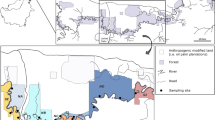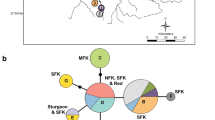Abstract
We examined resilience to extreme reduction of habitat, and long-term and long-distance isolation for an endemic species using California's Santa Barbara Island as a natural model. The island is smaller than 260 ha, has been isolated by 40 km of ocean from the nearest other island for more than 10,000 years and was severely impacted by human activities and feral browsers during at least the past 90 years. Less than 0.2 km2 of native plant cover remains, yet seven apparently endemic plants and animals persist, including a moth, Argyrotaenia isolatissima (Tortricidae). Using mitochondrial DNA sequence we examined the levels of genetic divergence between the moth and its closest relatives on the other Channel Islands and the California mainland. A. isolatissima has 15 bp differences, including one non-synonymous substitution, from the most closely related taxon, on San Nicolas Island. Both parsimony and likelihood-based molecular systematic analyses confirm the evolutionary independence of A. isolatissima and indicate that portions of an endemic flora and fauna may persist in small fragments, despite long-term isolation and disturbance. Habitat conservation planning may underestimate the value of very small, temporally and spatially isolated fragments of native habitat not only to maintain, but also to generate endemic biodiversity.
Similar content being viewed by others
References
Abensperg-Traun M. and Smith G.T. 1999. How small is too small for small animals? Four terrestrial arthropod species in different-sized remnant woodlands in agricultural Western Australia. Biodiversity and Conservation 8: 709–726.
Alonso A., Dallmeier F., Granek E. and Raven P. 2001. Biodiversity: connecting with the tapestry of life. Smithsonian Institution/Monitoring and Assessment of Biodiversity Program and President's Committee of Advisors on Science and Technology, Washington, DC.
Applied Biosystems Inc. 1994. Sequence Navigator. Applied Biosystems, Foster City, California.
Avise J.C. 2000. Phylogeography: The History and Formation of Species. Harvard University Press, Cambridge, Massachusetts.
Barbosa O. and Marquet P.A. 2002. Effects of forest fragmentation on the beetle assemblage at the relict forest of Fray Jorge, Chile. Oecologia 132: 296–306.
Brower A.V.Z. 1994. Rapid morphological radiation and convergence among races of the butterfly Heliconius erato inferred from patterns of mitochondrial DNA evolution. Proceedings of the National Academy of Science USA 91: 6491–6495.
Caterino M.S., Cho S. and Sperling F.A.H. 2000. The current state of insect molecular systematics: a thriving tower of Babel. Annual Review of Entomology 45: 1–54.
Caterino M.S., Reed R.D., Kuo M.M. and Sperling F.A.H. 2001. A partitioned likelihood analysis of swallowtail butterfly phylogeny (Lepidoptera: Papilionidae). Systematic Biology 50: 106–127.
Cracraft J. 1983. The significance of phylogenetic classifications for systematic and evolutionary biology. In: Felsenstein J. (ed), Numerical Taxonomy. Springer, Berlin, Germany, pp. 1–17.
Daily M. (ed) 1993. Santa Barbara Island. Occasional Paper 6, Santa Cruz Island Foundation, Santa Barbara, California, x+ 112 pp.
Demboski J.R., Jacobsen B.K. and Cook J.A. 1998. Implications of cytochrome b sequence variation for biogeography and conservation of the northern flying squirrels (Glaucomys sabrinus) of the Alexander Archipelago, Alaska. Canadian Journal of Zoology 76: 1771–1777.
Duvernell D.D. and Turner B.J. 1998. Evolutionary genetics of Death Valley pupfish populations: mitochondrial DNA sequence variation and population structure. Molecular Ecology 7: 279–288.
Echelle A.A., Van Den Bussche R.A., Malloy Jr. T.P., Haynie M.M. and Minckley C.O. 2000. Mitochondrial DNA variation in pupfishes assigned to the Cyprinodon macularius (Atherinomorpha: Cyprinodontidae): taxonomic implications and conservation genetics. Copeia 2: 353–364.
Fleishman E., Launer A.E., Weiss S.B., Reed M.J., Boggs C.L., Murphy D.D. and Ehrlich P.R. 2000. Effects of microclimate and oviposition timing on prediapause larval survival of the bay checkerspot butterfly, Euphydryas editha bayensis (Lepidoptera: Nymphalidae). Journal of Research on the Lepidoptera 36: 31–44.
Fox B.J. and Fox M.D. 2000. Factors determining mammal species richness on habitat islands and isolates: habitat diversity, disturbance, species interactions, and guild assembly rules. Global Ecology and Biogeography 9: 19–37.
Gillespie J.H. 1991. The Causes of Molecular Evolution. Oxford University Press, Oxford, UK.
Green D.M., Sharbel T.F., Kearsley J. and Kaiser H. 1996. Postglacial range fluctuations, genetic subdivision and speciation in the western North American spotted frog complex, Rana pretiosa. Evolution 50: 374–390.
Hanski I. 1994. Patch-occupancy dynamics in fragmented landscapes. Trends in Ecology and Evolution 9: 131–135.
Haikola S., Fortelius W., O'Hara R.B., Kuussaari M., Wahlberg N., Saccheri I.J. et al. 2001. Inbreeding depression and the maintenance of genetic load in Melitaea cinxia metapopulations. Conservation Genetics 2: 325–335.
Harris L.D. 1984. The Fragmented Forest: Island Biogeography Theory and the Preservation of Biotic Diversity. University of Chicago Press, Chicago, Illinois.
Hasegawa M., Kishino K. and Yano T. 1985. Dating the human–ape splitting by a molecular clock of mitochondrial DNA. Journal of Molecular Evolution 32: 443–445.
Hedin M.C. 1997. Speciational history in a diverse clade of habitat-specialized spiders (Araneae: Nesticidae: Nesticus): inferences from geographic-based sampling. Evolution 51: 1929–1945.
Keller L.F. and Waller D.M. 2002. Inbreeding effects in wild populations. Trends in Ecology and Evolution 17: 230–241.
Kim I., Phillips C.J., Monjeau J.A., Birney E.C., Noack K., Pumo D.E. et al. 1998. Habitat islands, genetic diversity, and gene flow in a Patagonian rodent. Molecular Ecology 7: 667–678.
Landry B., Powell J.A. and Sperling F.A.H. 1999. Systematics of the Argyrotaenia franciscana (Lepidoptera: Tortricidae) species group: evidence from mitochondrial DNA. Annals of the Entomological Society of America 92: 40–46.
Lawes M.J., Mealin P.E. and Piper S.E. 2000. Patch occupancy and potential metapopulation dynamics of three forest mammals in fragmented afromontane forest in South Africa. Conservation Biology 14: 1088–1098.
Li W.-H. 1997. Molecular Evolution. Sinauer Associates, Sunderland, Massachusetts.
Liebherr J.K. and Zimmerman E.C. 2000. Insects of Hawaii: Hawaiian Carabidae (Coleoptera), Part 1, Vol. 16. University of Hawaii Press, Honolulu, Hawaii.
Lipps J.H., Valentine J.W. and Mitchell E. 1968. Pleistocene paleoecology and biostratigraphy, Santa Barbara Island, California. Journal of Paleontology 42: 291–307.
MacArthur R.H. and Wilson E.O. 1967. The Theory of Island Biogeography. Princeton University Press, Princeton, New Jersey.
Moore W.S. 1995. Inferring phylogenies from mtDNA variation: mitochondrial-gene trees versus nuclear-gene trees. Evolution 49: 718–726.
Myers M.J., Sperling F.A.H. and Resh V.H. 2001. Dispersal of two species of Trichoptera from desert springs: conservation implications for isolated vs. connected populations. Journal of Insect Conservation 5: 207–215.
Palo J., Varvio S.-L., Hanski I. and Vainola R. 1995. Developing microsatellite markers for insect population structure: complex variation in a checkerspot butterfly. Hereditas 123: 295–300.
Philbrick R.N. 1972. The plants of Santa Barbara Island, California. Madrono 21: 329–393.
Porter B.A., Cavender T.M. and Fuerst P.A. 2002. Molecular phylogeny of the snubnose darters, sub-genus Ulocentra (genus Etheostoma, family Percidae). Molecular Phylogenetics and Evolution 22: 364–374.
Posada D. and Crandall K.A. 1998. Modeltest: testing the model of DNA substitution. Bioinformatics 14: 817–818.
Powell J.A. 1964. Biological and taxonomic studies on tortricine moths, with reference to the species in California. University of California Publications in Entomology 32: 1–317.
Powell J.A. 1994. Biogeography of Lepidoptera on the California Channel Islands. In: Halvorson W. and Maender G. (eds) The Fourth California Islands Symposium: Update on the Status of Resources. Santa Barbara Museum of Natural History, Santa Barbara, California, pp. 449–464.
Reed R.D. and Sperling F.A.H. 1999. Interaction of process partitions in phylogenetic analysis: an example from the swallowtail butterfly genus Papilio. Molecular Biology and Evolution 16: 286–297.
Rentz D.C. and Weissman D.B. 1973. The origins and affinities of the Orthoptera of the Channel Islands and adjacent mainland California. Part I. The genus Cnemotettix. Proceedings of the Academy of Natural Sciences of Philadelphia 125: 89–120.
Rentz D.C. and Weissman D.B. 1982. Faunal affinities, systematics, and bionomics of the Orthoptera of the California Channel Islands. University of California Publications in Entomology 94, 240 pp.
Rodriguez F., Oliver J.F., Marin A. and Medina J.R. 1990. The general stochastic model of nucleotide substitution. Journal of Theoretical Biology 142: 485–501.
Rubinoff D. 2001. Evaluating the California gnatcatcher as an umbrella species for conservation of coastal sage scrub. Conservation Biology 15: 1374–1383.
Rubinoff D. and Sperling F.A.H. 2002. Evolution of ecological traits and wing morphology in Hemileuca (Saturniidae) based on a two gene phylogeny. Molecular Phylogenetics and Evolution 25: 70–86.
Sanderson E.W., Redford K.H., Chetkiewicz C.B., Medellin R.A., Rabinowitz A.R., Robinson J.G. and Taber A.B. 2002. Planning to save a species: the jaguar as a model. Conservation Biology 16: 58–72.
Schoenherr A.A., Feldmeth C.R. and Emerson M.J. 1999. Natural History of the Islands of California, California Natural History Guides 61. University of California Press, Berkeley and Los Angeles, California, xi+ 491 pp.
Simberloff D. 1995. Habitat fragmentation and population extinction of birds. Ibis 137 (Suppl. 1): 105–111.
Sorenson M.D. 1999. TreeRot, Version 2. Boston University, Boston, Massachusetts. http: //mightyduck. bu.edu/TreeRot/index.html.
Sperling F.A.H. 1993. Mitochondrial DNA variation and Haldane's rule in the Papilio glaucus and P. troilus species groups. Heredity 71: 227–233.
Sperling F.A.H. 1994. Sex-linked genes and species differences in Lepidoptera. Canadian Entomology 126: 807–818.
Sperling F.A.H., Spence J.R. and Andersen N.M. 1997. Mitochondrial DNA, allozymes, morphology, and hybrid compatibility in Limnoporus water striders (Heteroptera: Gerridae): do they all track species phylogenies? Annals of the Entomological Society of America 90: 401–414.
Swofford D.L. 2002. PAUP*. Phylogenetic analysis using parsimony (*and other methods). Version 4. Sinauer Associates, Sunderland, Massachusetts.
Szalanski A.L., Sikes D.S., Bischof R. and Fritz M. 2000. Population genetics and phylogenetics of the endangered American burying beetle, Nicrophorus americanus (Coleoptera: Silphidae). Annals of the Entomological Society of America 93: 589–594.
Talbot S.L. and Shields G.F. 1996. Phylogeography of brown bears (Ursus arctos) of Alaska and paraphyly within the Ursidae. Molecular Phylogenetics and Evolution 5: 477–494.
Vucetich L.M., Vucetich J.A., Joshi C.P., Waite T.A. and Peterson R.O. 2001. Genetic (RAPD) diversity in Peromyscus maniculatus populations in a naturally fragmented landscape. Molecular Ecology 10: 35–40.
Walter H.S. 1990. Small viable population: the red-tailed hawk of Socorro Island. Conservation Biology 4: 441–443.
Whitcomb R.F., Robbins C.S., Lynch J.F., Whitcomb B.L., Klimkiewicz M.K. and Bystrak D. 1981. Effects of forest fragmentation on avifauna of the eastern deciduous forest. In: Burgess R.L. and Sharpe D.M. (eds) Forest Island Dynamics in Man-dominated Landscapes. Springer-Verlag, New York, pp. 125–213.
Whittaker R.J., Jones S.H. and Partomihardjo T. 1997. The rebuilding of an isolated rain forest assemblage: how disharmonic is the flora of Krakatau? Biodiversity and Conservation 6: 1671–1696.
Author information
Authors and Affiliations
Rights and permissions
About this article
Cite this article
Rubinoff, D., Powell, J.A. Conservation of fragmented small populations: endemic species persistence on California's smallest channel island. Biodiversity and Conservation 13, 2537–2550 (2004). https://doi.org/10.1023/B:BIOC.0000048453.56515.d3
Issue Date:
DOI: https://doi.org/10.1023/B:BIOC.0000048453.56515.d3




